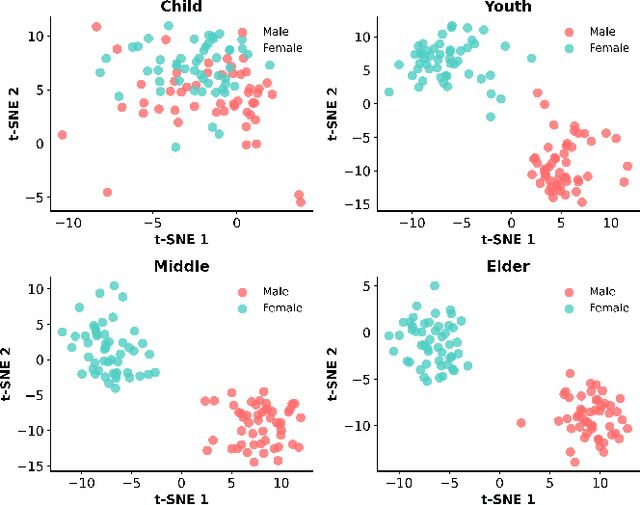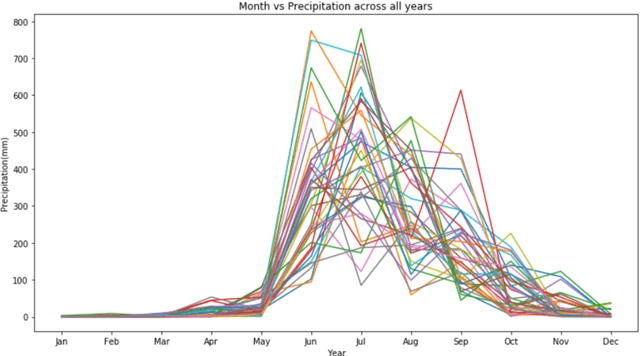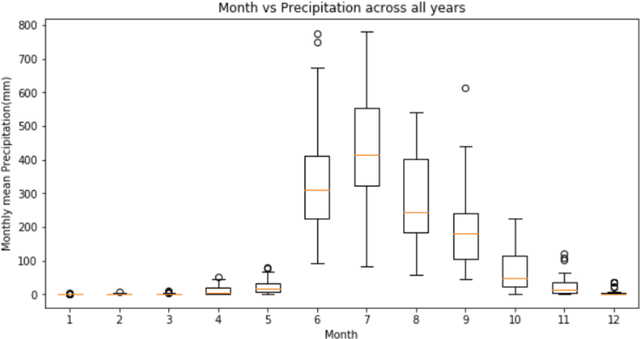Yuchen Wang
MAR:Multi-Agent Reflexion Improves Reasoning Abilities in LLMs
Dec 23, 2025Abstract:LLMs have shown the capacity to improve their performance on reasoning tasks through reflecting on their mistakes, and acting with these reflections in mind. However, continual reflections of the same LLM onto itself exhibit degeneration of thought, where the LLM continues to repeat the same errors again and again even with the knowledge that its wrong. To address this problem, we instead introduce multi-agent with multi-persona debators as the method to generate reflections. Through out extensive experimentation, we've found that the leads to better diversity of in the reflections generated by the llm agent. We demonstrate an accuracy of 47% EM HotPot QA (question answering) and 82.7% on HumanEval (programming), both performances surpassing reflection with a single llm.
GateFusion: Hierarchical Gated Cross-Modal Fusion for Active Speaker Detection
Dec 17, 2025Abstract:Active Speaker Detection (ASD) aims to identify who is currently speaking in each frame of a video. Most state-of-the-art approaches rely on late fusion to combine visual and audio features, but late fusion often fails to capture fine-grained cross-modal interactions, which can be critical for robust performance in unconstrained scenarios. In this paper, we introduce GateFusion, a novel architecture that combines strong pretrained unimodal encoders with a Hierarchical Gated Fusion Decoder (HiGate). HiGate enables progressive, multi-depth fusion by adaptively injecting contextual features from one modality into the other at multiple layers of the Transformer backbone, guided by learnable, bimodally-conditioned gates. To further strengthen multimodal learning, we propose two auxiliary objectives: Masked Alignment Loss (MAL) to align unimodal outputs with multimodal predictions, and Over-Positive Penalty (OPP) to suppress spurious video-only activations. GateFusion establishes new state-of-the-art results on several challenging ASD benchmarks, achieving 77.8% mAP (+9.4%), 86.1% mAP (+2.9%), and 96.1% mAP (+0.5%) on Ego4D-ASD, UniTalk, and WASD benchmarks, respectively, and delivering competitive performance on AVA-ActiveSpeaker. Out-of-domain experiments demonstrate the generalization of our model, while comprehensive ablations show the complementary benefits of each component.
Dropout Prompt Learning: Towards Robust and Adaptive Vision-Language Models
Dec 08, 2025Abstract:Dropout is a widely used regularization technique which improves the generalization ability of a model by randomly dropping neurons. In light of this, we propose Dropout Prompt Learning, which aims for applying dropout to improve the robustness of the vision-language models. Different from the vanilla dropout, we apply dropout on the tokens of the textual and visual branches, where we evaluate the token significance considering both intra-modal context and inter-modal alignment, enabling flexible dropout probabilities for each token. Moreover, to maintain semantic alignment for general knowledge transfer while encouraging the diverse representations that dropout introduces, we further propose residual entropy regularization. Experiments on 15 benchmarks show our method's effectiveness in challenging scenarios like low-shot learning, long-tail classification, and out-of-distribution generalization. Notably, our method surpasses regularization-based methods including KgCoOp by 5.10% and PromptSRC by 2.13% in performance on base-to-novel generalization.
Robust Decentralized Multi-armed Bandits: From Corruption-Resilience to Byzantine-Resilience
Nov 13, 2025Abstract:Decentralized cooperative multi-agent multi-armed bandits (DeCMA2B) considers how multiple agents collaborate in a decentralized multi-armed bandit setting. Though this problem has been extensively studied in previous work, most existing methods remain susceptible to various adversarial attacks. In this paper, we first study DeCMA2B with adversarial corruption, where an adversary can corrupt reward observations of all agents with a limited corruption budget. We propose a robust algorithm, called DeMABAR, which ensures that each agent's individual regret suffers only an additive term proportional to the corruption budget. Then we consider a more realistic scenario where the adversary can only attack a small number of agents. Our theoretical analysis shows that the DeMABAR algorithm can also almost completely eliminate the influence of adversarial attacks and is inherently robust in the Byzantine setting, where an unknown fraction of the agents can be Byzantine, i.e., may arbitrarily select arms and communicate wrong information. We also conduct numerical experiments to illustrate the robustness and effectiveness of the proposed method.
Deep Dubbing: End-to-End Auto-Audiobook System with Text-to-Timbre and Context-Aware Instruct-TTS
Sep 19, 2025



Abstract:The pipeline for multi-participant audiobook production primarily consists of three stages: script analysis, character voice timbre selection, and speech synthesis. Among these, script analysis can be automated with high accuracy using NLP models, whereas character voice timbre selection still relies on manual effort. Speech synthesis uses either manual dubbing or text-to-speech (TTS). While TTS boosts efficiency, it struggles with emotional expression, intonation control, and contextual scene adaptation. To address these challenges, we propose DeepDubbing, an end-to-end automated system for multi-participant audiobook production. The system comprises two main components: a Text-to-Timbre (TTT) model and a Context-Aware Instruct-TTS (CA-Instruct-TTS) model. The TTT model generates role-specific timbre embeddings conditioned on text descriptions. The CA-Instruct-TTS model synthesizes expressive speech by analyzing contextual dialogue and incorporating fine-grained emotional instructions. This system enables the automated generation of multi-participant audiobooks with both timbre-matched character voices and emotionally expressive narration, offering a novel solution for audiobook production.
The Sound of Risk: A Multimodal Physics-Informed Acoustic Model for Forecasting Market Volatility and Enhancing Market Interpretability
Aug 26, 2025



Abstract:Information asymmetry in financial markets, often amplified by strategically crafted corporate narratives, undermines the effectiveness of conventional textual analysis. We propose a novel multimodal framework for financial risk assessment that integrates textual sentiment with paralinguistic cues derived from executive vocal tract dynamics in earnings calls. Central to this framework is the Physics-Informed Acoustic Model (PIAM), which applies nonlinear acoustics to robustly extract emotional signatures from raw teleconference sound subject to distortions such as signal clipping. Both acoustic and textual emotional states are projected onto an interpretable three-dimensional Affective State Label (ASL) space-Tension, Stability, and Arousal. Using a dataset of 1,795 earnings calls (approximately 1,800 hours), we construct features capturing dynamic shifts in executive affect between scripted presentation and spontaneous Q&A exchanges. Our key finding reveals a pronounced divergence in predictive capacity: while multimodal features do not forecast directional stock returns, they explain up to 43.8% of the out-of-sample variance in 30-day realized volatility. Importantly, volatility predictions are strongly driven by emotional dynamics during executive transitions from scripted to spontaneous speech, particularly reduced textual stability and heightened acoustic instability from CFOs, and significant arousal variability from CEOs. An ablation study confirms that our multimodal approach substantially outperforms a financials-only baseline, underscoring the complementary contributions of acoustic and textual modalities. By decoding latent markers of uncertainty from verifiable biometric signals, our methodology provides investors and regulators a powerful tool for enhancing market interpretability and identifying hidden corporate uncertainty.
Handling Imbalanced Pseudolabels for Vision-Language Models with Concept Alignment and Confusion-Aware Calibrated Margin
May 04, 2025Abstract:Adapting vision-language models (VLMs) to downstream tasks with pseudolabels has gained increasing attention. A major obstacle is that the pseudolabels generated by VLMs tend to be imbalanced, leading to inferior performance. While existing methods have explored various strategies to address this, the underlying causes of imbalance remain insufficiently investigated. To fill this gap, we delve into imbalanced pseudolabels and identify two primary contributing factors: concept mismatch and concept confusion. To mitigate these two issues, we propose a novel framework incorporating concept alignment and confusion-aware calibrated margin mechanisms. The core of our approach lies in enhancing underperforming classes and promoting balanced predictions across categories, thus mitigating imbalance. Extensive experiments on six benchmark datasets with three learning paradigms demonstrate that the proposed method effectively enhances the accuracy and balance of pseudolabels, achieving a relative improvement of 6.29% over the SoTA method. Our code is avaliable at https://anonymous.4open.science/r/CAP-C642/
DexFlow: A Unified Approach for Dexterous Hand Pose Retargeting and Interaction
May 02, 2025Abstract:Despite advances in hand-object interaction modeling, generating realistic dexterous manipulation data for robotic hands remains a challenge. Retargeting methods often suffer from low accuracy and fail to account for hand-object interactions, leading to artifacts like interpenetration. Generative methods, lacking human hand priors, produce limited and unnatural poses. We propose a data transformation pipeline that combines human hand and object data from multiple sources for high-precision retargeting. Our approach uses a differential loss constraint to ensure temporal consistency and generates contact maps to refine hand-object interactions. Experiments show our method significantly improves pose accuracy, naturalness, and diversity, providing a robust solution for hand-object interaction modeling.
Multidimensional precipitation index prediction based on CNN-LSTM hybrid framework
Apr 29, 2025



Abstract:With the intensification of global climate change, accurate prediction of weather indicators is of great significance in disaster prevention and mitigation, agricultural production, and transportation. Precipitation, as one of the key meteorological indicators, plays a crucial role in water resource management, agricultural production, and urban flood control. This study proposes a multidimensional precipitation index prediction model based on a CNN- LSTM hybrid framework, aiming to improve the accuracy of precipitation forecasts. The dataset is sourced from Pune, Maharashtra, India, covering monthly mean precipitation data from 1972 to 2002. This dataset includes nearly 31 years (1972-2002) of monthly average precipitation, reflecting the long-term fluctuations and seasonal variations of precipitation in the region. By analyzing these time series data, the CNN-LSTM model effectively captures local features and long-term dependencies. Experimental results show that the model achieves a root mean square error (RMSE) of 6.752, which demonstrates a significant advantage over traditional time series prediction methods in terms of prediction accuracy and generalization ability. Furthermore, this study provides new research ideas for precipitation prediction. However, the model requires high computational resources when dealing with large-scale datasets, and its predictive ability for multidimensional precipitation data still needs improvement. Future research could extend the model to support and predict multidimensional precipitation data, thereby promoting the development of more accurate and efficient meteorological prediction technologies.
From Code Generation to Software Testing: AI Copilot with Context-Based RAG
Apr 02, 2025Abstract:The rapid pace of large-scale software development places increasing demands on traditional testing methodologies, often leading to bottlenecks in efficiency, accuracy, and coverage. We propose a novel perspective on software testing by positing bug detection and coding with fewer bugs as two interconnected problems that share a common goal, which is reducing bugs with limited resources. We extend our previous work on AI-assisted programming, which supports code auto-completion and chatbot-powered Q&A, to the realm of software testing. We introduce Copilot for Testing, an automated testing system that synchronizes bug detection with codebase updates, leveraging context-based Retrieval Augmented Generation (RAG) to enhance the capabilities of large language models (LLMs). Our evaluation demonstrates a 31.2% improvement in bug detection accuracy, a 12.6% increase in critical test coverage, and a 10.5% higher user acceptance rate, highlighting the transformative potential of AI-driven technologies in modern software development practices.
 Add to Chrome
Add to Chrome Add to Firefox
Add to Firefox Add to Edge
Add to Edge